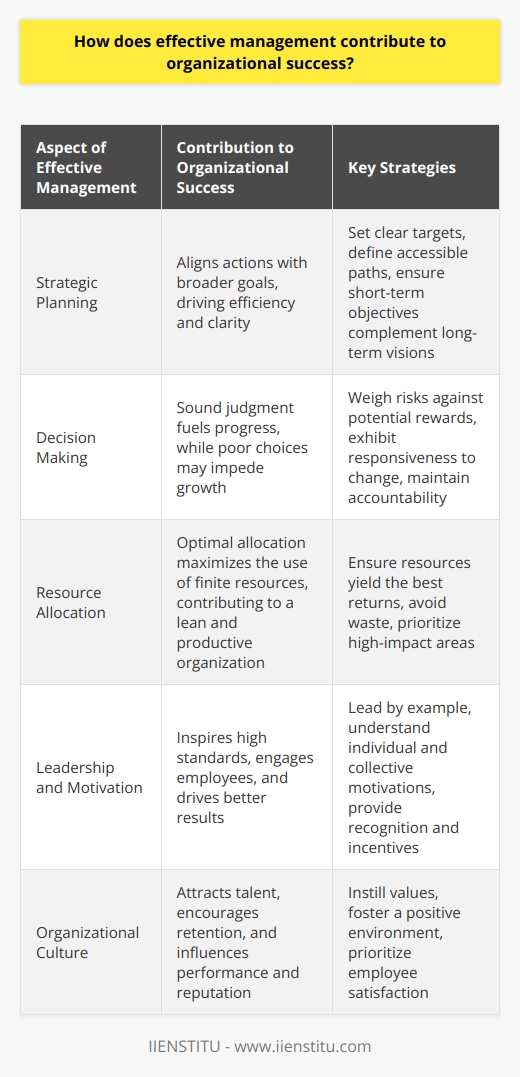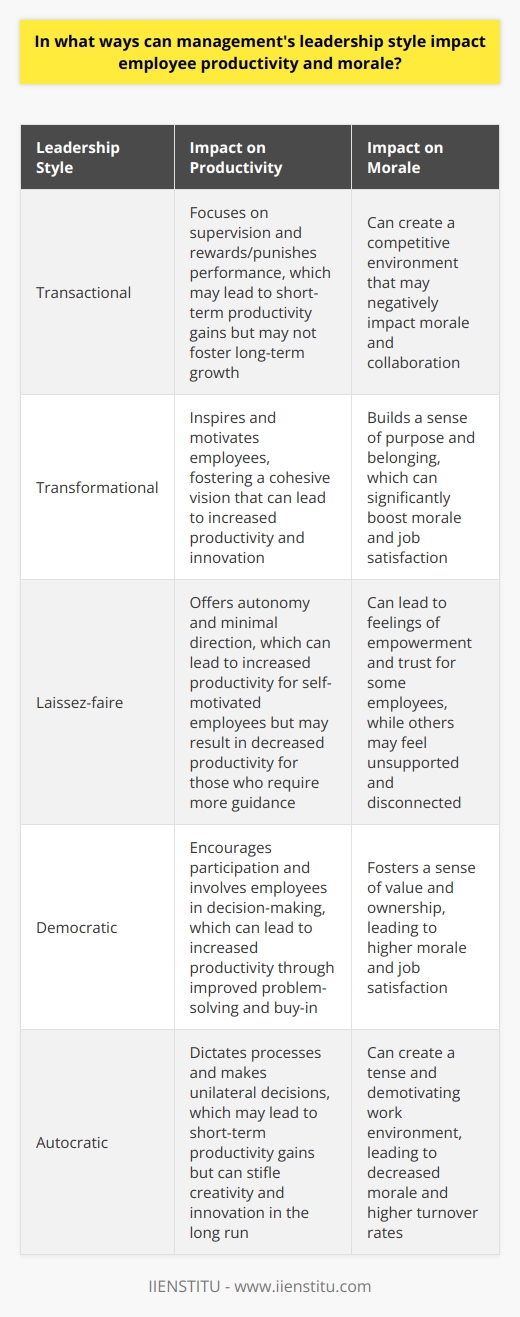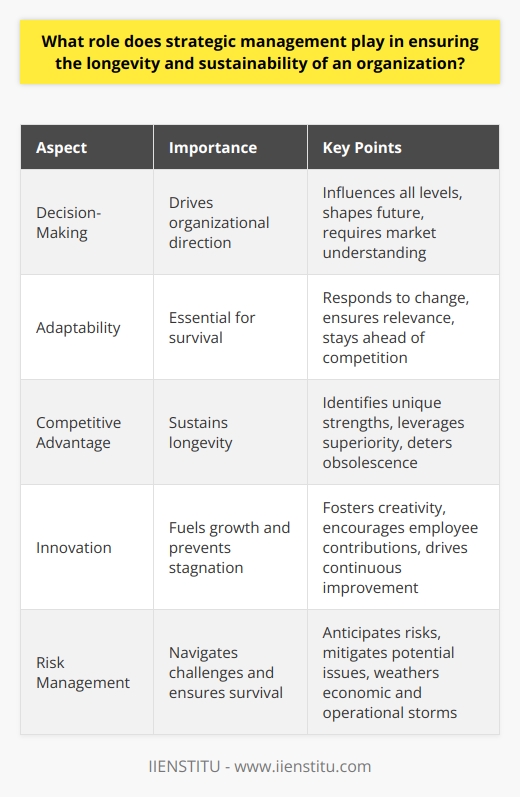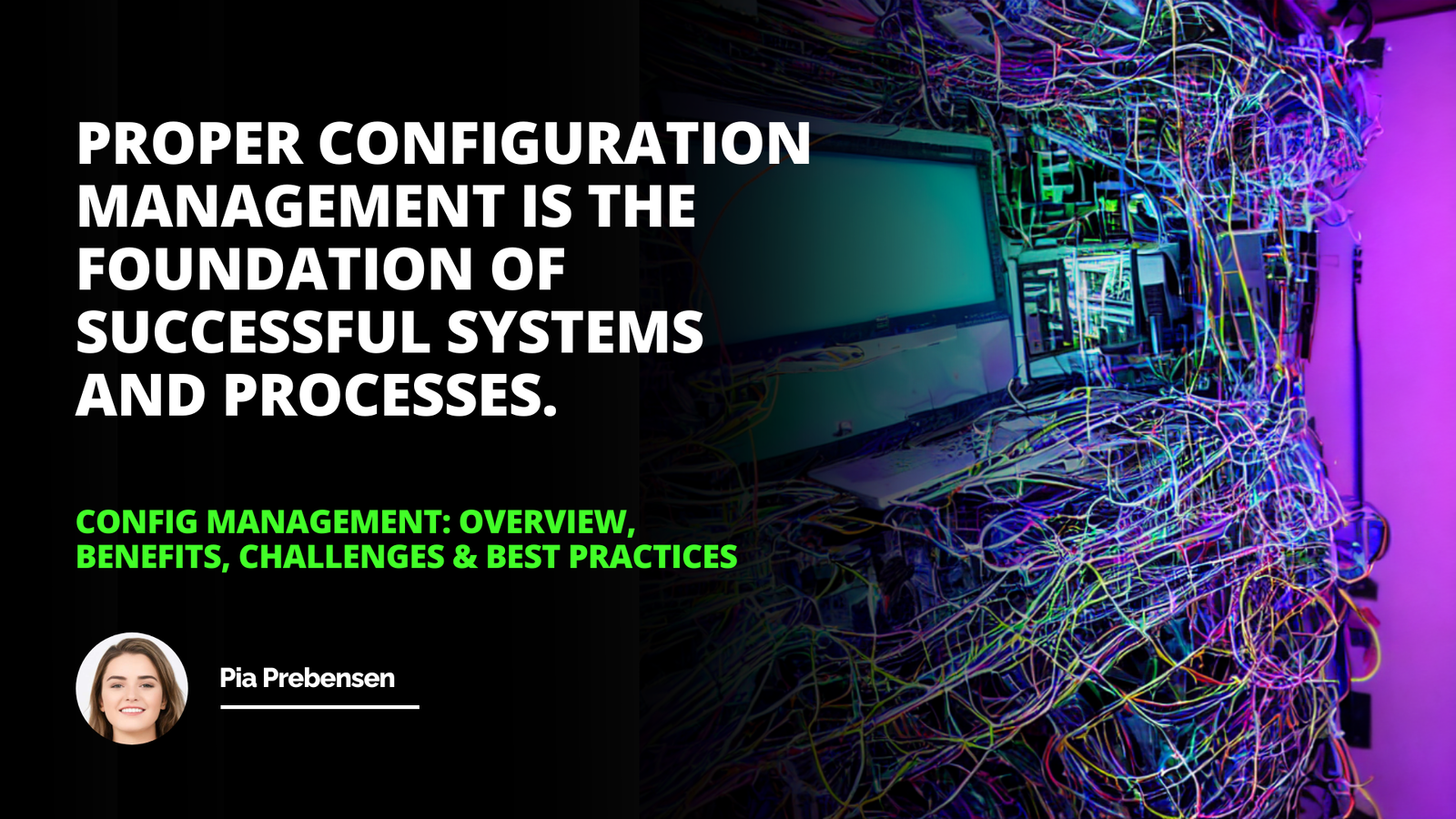
The echelons of management hold a pivotal role in determining Organizational Success. With a labyrinth of influences at play, it is Management Effectiveness that often dictates whether an organization soars or stumbles. Within this complex matrix, Leadership Impacts and Management Roles emerge as crucial determinants of successful outcomes, interwoven with the strategic scaffolding erected through Strategic Planning.
Establishing a groundwork for excellence is an intricate endeavor, shaped by the dynamic interplay of direction, influence, and adaptive strategies.
This article seeks to delve into the intricate tapestry that constitutes exceptional leadership and strategic management, linking theory with practice, through experiential insights and a parsing of real-world implications.
By charting a course from the theoretical foundations to the practical applications of management roles, this exposition aims to construct a comprehensive understanding of the mechanisms through which an organization thrives.
As we navigate the intricacies of strategic planning, the fostering of a prosperous organizational culture, and the varied styles of leadership, a holistic picture of organizational success shall emerge.
The Foundation of Success: Strategic Planning in Management
Strategic Planning and Vision Setting
In the hierarchical scheme of managerial functions, Strategic Planning sits at the zenith, serving as a beacon that guides the organization towards its designated horizon. It is a deliberate process, encompassing a broad spectrum of activities from conceptualizing long-term objectives to crafting the actionable tactics essential for their attainment. Strategic planning seeks symmetry between an organization's core competencies and the untapped potential within its market domain.
The alignment of strategic planning with Organizational Success cannot be overstated. A roadmap dotted with well-articulated destinations drives an organization's momentum, directing its journey through the turbulences of market landscapes. Here, leadership cannot be a silent spectator; on the contrary, it is the leader’s prescience and acumen in setting a vision that galvanizes an entire organization towards unity of purpose.
Implementation of Strategic Goals
Transitioning from the ethereal realms of vision to the tangible ambit of operational execution, the implementation of strategic goals heralds the true test of management's mettle. This phase is characterized by the transmutation of grand designs into specific, measurable, and time-bound objectives that teams can strive towards. Management Effectiveness reveals itself in the finesse with which these goals are disseminated and pursued across the organizational spectrum.
Central to management's effectiveness is its ability to marshal resources, human and material, guiding them through a structured progression towards envisioned benchmarks. Real-world examples abound of organizations that have catapulted to preeminence by adroitly negotiating this passage from plan to performance—where clarity of directive and the orchestration of efforts coalesce to yield triumphant campaigns.
Cultivating a Positive Organizational Culture
Beyond the stark metrics of success and the strides made on balance sheets, it is the cultivation of a positive Organizational Culture that sustains an enterprise. Management's role in nurturing such a culture is akin to that of a gardener who tends to the soil that will hold the seeds of prosperity. It is an environment where trust sprouts, ideas flourish, and employees thrive, engendered by the careful tilling of norms, values, and practices.
Culture serves as the subliminal current that powers the engine of employee morale and productivity. A culture steeped in positive affirmation, recognition, and growth fosters a workforce that is innovative, committed, and aligned with the organization's strategic impetus. Leadership here sets the bar, not merely in articulating expectations but in embodying them, emanating the ethos that will permeate every echelon.
Key Management Roles in Facilitating Organizational Success
Decision-Making and Responsibility
At the helm of an organization's ship, management stands at the decision-making wheel, steering through the fog of uncertainty and the straits of complexity. The foresight elicited in these decisions can be the wind behind a company's sails or the reef upon which future prospects are dashed. Balancing the scales of risk and innovation calls for a judicious temperance and sagacity that can secure progress without courting peril.
Responsibility and accountability are the twin sentinels overseeing effective decision-making. It is within the crucible of choice that leadership's mettle is refined. Whether navigating the introduction of a disruptive technology, forging a merger, or making a critical market exit, an effective leader's resolve in decision-making bolsters the very pillars upon which the organization rests.
Communication and Collaboration
Clear, cogent, and timely Communication is the sinew that binds the muscle of an organization's efforts. Without it, initiatives flounder, misunderstandings proliferate, and collective endeavor sputters. In safeguarding the pathways of communication, management ensures that plans are understood, objectives are embraced, and feedback loops are institutionalized.
Collaboration underpins the multi-disciplinary tapestry of modern organizations. Management – the weaver of this tapestry – must enable a synthesis of talents, fostering a milieu where cross-pollination of ideas is not just encouraged but expected. The efficacy of Management Roles in creating collaborative frameworks translates directly to a unified and potent problem-solving force.
Leadership Impacts: How Management Styles Influence Outcomes
Different Leadership Styles and Their Effects
Leadership is a chameleon, assuming varied hues and postures in accordance with the context and cultural milieu of an organization. The spectrums of styles, ranging from authoritative to participative to laissez-faire, delineate different realms of influence and operation. Each style carries with it idiomatic impacts on the organizational fabric, modulating dynamics in distinct but discernible ways.
Autocratic leaders may drive swift decision-making, but often at the cost of stifling creative dissent. Conversely, democratic leaders might champion inclusivity and collective buy-in, potentially tempering the pace of execution. Examining the success of various organizations provides a casebook of how certain styles have garnered success where others might falter, shaped in part by the nature of industry and the temperament of the workforce.
Fostering Employee Development and Engagement
An organization's vitality is inseparable from the well-being and development of its employees. Responsive and insightful management actively invests in the enhancement of its workforce's skill set, recognizing that the growth of individuals inexorably contributes to the expansion of the entire enterprise. Leadership, in this regard, manifests a nurturing spirit, fostering conditions for learning and progression.
Increasing employee engagement and motivation is not a peripheral task but a core tenet of enlightened leadership. Engaged employees are the bedrock on which excellence is built and sustained. Through recognition, challenge, and inspiration, leadership works to forge an alloy of dedicated professionals, each member resolute in their commitment to the collective vision.
Navigating Changes and Challenges
The ever-shifting sands of the business landscape demand adaptive and resilient responses from those at the managerial helm. Effective management becomes a beacon through the fog of change, maintaining focus while guiding the organization through the tumult of transitions. Leadership, especially in times of crisis, can fortify an organization, embedding resilience that endures beyond the episodic challenges.
Most Searched Long Tail Keyword For Fundamentals Of Management And Its Functions
Manager's Role İn Organizations Key Insights Pdf Effective Leadership Strategies
Well-documented case studies serve as testament to the quintessential role of management during periods of upheaval. From market downturns to radical technological disruptions, it is the astuteness and agility of leadership that armors an organization against existential threats and steers it toward new avenues of opportunity.
Integrating Management Effectiveness for Sustained Success
In synthesizing the various facets examined, it becomes apparent that the mosaic of management's impact is both profound and permeating. This exploration has underscored the multifaceted influence of strategic planning, cultural cultivation, decision-making acumen, and communicative clarity—all emanating from the central engine of leadership.
The enduring narrative is one that binds the continuity of leadership with the evolution of strategic objectives, illustrating a cycle of perpetual propulsion towards success. Effective management thus remains the cornerstone—a touchstone that keeps the organization aligned with its pursuit of enduring achievement.
Further Reading and Case Studies
For those questing after deeper insights into the nexus of management, leadership, and organizational success, an expansive repository of knowledge awaits. Engaging with business related courses and reputable online courses proffers an opportunity to deepen one's understanding of the nuanced interplay between the various elements that determine an organization's trajectory. Within these resources lie a rich conglomeration of case studies, scholarly articles, and texts authored by leading minds in the field, all beckoning the inquisitive and the ambitious alike.
Frequently Asked Questions
How does effective management contribute to organizational success?
Effective Management and Organizational Success
Effective management stands as a pillar in achieving organizational success. It involves strategic planning, leadership, and oversight of resources and processes. Management shapes the organization's culture and sets the foundation for a positive work environment.
Strategic Planning
Strategic planning guides the organization towards its objectives. It ensures that every action aligns with the broader goals. Managers set clear targets. They define accessible paths for achieving them. Short-term objectives complement long-term visions. Teams understand their roles in the grand scheme. Clarity drives efficiency.
Decision Making
Decisions impact outcomes. Managers must exhibit sound judgment. They weigh risks against potential rewards. Good decisions fuel progress. Poor choices may impede growth. Management is accountable for these choices. Responsiveness to change protects against stagnation. Adaptability becomes a competitive advantage.
Resource Allocation
Resources are finite. Effective management maximizes their use. Human, financial, and material resources require careful handling. Managers ensure resources go where they yield the best returns. Wasted resources equal missed opportunities. Optimal allocation contributes to a lean, productive organization.
Leadership and Motivation
Managers lead by example. Their behavior sets the tone. High standards in management inspire the same throughout the ranks. Motivation lies at the heart of performance. Managers understand individual and collective motivations. Recognition and incentives drive employee engagement. Engaged employees produce better results.
Communication
Clear communication is essential. It connects every level of the organization. Managers convey goals, feedback, and adjust directions as needed. Information flows both ways. This open line fosters trust and collaboration.
Organizational Culture
Culture reflects the organization's values. Management instills these values. A positive culture attracts talent. It encourages retention. Happy employees often mean satisfied customers. Thus, culture influences performance and reputation.
Monitoring and Feedback
Continuous improvement underpins success. Managers monitor processes and outcomes. They solicit feedback. Input from teams refines strategies. Continuous monitoring detects issues early. Prompt feedback allows for quick corrections. This cycle promotes ongoing enhancement.
Risk Management
Risks pose threats to stability. Effective management identifies these threats. It develops plans to mitigate them. Managers anticipate potential pitfalls. They prepare contingency plans. Preparedness reduces the impact of adverse events.
Ethical Standards
Organizations thrive on trust. Ethical management builds this trust. It promotes a reputation for integrity. Customers and partners seek reliable organizations. Employees respect ethical workplaces. Ethical standards shape every decision.
In sum, successful management is multifaceted. It ensures alignment towards a common goal. It entails strategic resource use. Managers lead, motivate, and maintain high standards. They communicate openly and foster a robust culture. Monitoring and ethical practice are non-negotiable. Sound management practices lead organizations to thrive.

In what ways can management's leadership style impact employee productivity and morale?
Impact of Leadership on Employee Productivity and Morale
Understanding Leadership Styles
Leadership styles shape team dynamics. They influence workplace environments. Varied styles have different effects. Transactional leaders focus on supervision. They reward or punish performance. Transformational leaders inspire and motivate. They foster a cohesive vision. Laissez-faire leaders offer autonomy. They provide minimal direction. Democratic leaders encourage participation. They involve employees in decisions. Autocratic leaders dictate processes. They make unilateral decisions.
Leadership Effect on Productivity
Clear communication drives results. It sets expectations. It aligns team goals. Consistent feedback improves performance. It helps address issues. It fine-tunes workflows. Autonomy boosts innovation. It allows creative solutions. It enables flexible thinking. Recognition sustains momentum. It values employees. It encourages continuous effort. Micromanagement impedes productivity. It stifles independence. It increases stress.
Leadership Influence on Morale
Employee involvement increases satisfaction. It acknowledges contributions. It shares successes. Distrust generates morale loss. It erodes team spirit. It discourages initiative. Supportive environments enhance well-being. They nurture growth. They promote balance. Inconsistent policies cause frustration. They confuse staff. They create uncertainty. Empowerment fosters loyalty. It builds confidence. It strengthens commitment.
Balancing Leadership for Optimal Outcomes
Effective leaders adapt styles. They assess team needs. They pivot strategies accordingly. They blend approaches wisely. They leverage diverse strengths. They mitigate potential weaknesses. Successful leadership demands balance. It seeks optimal productivity. It prioritizes employee morale.

What role does strategic management play in ensuring the longevity and sustainability of an organization?
Understanding Strategic Management
Strategic management serves as the backbone of an organization. It ensures a clear path is set. This path aligns with the organization’s mission. It also supports the vision the organization aspires to achieve. Leadership relies on strategic management. It translates goals into action. Long-term objectives find direction in this process.
The Heart: Decision-Making
Strategic management drives decision-making. It influences all levels of an organization. Leaders choose actions that shape the future. These choices often dictate the company's trajectory. They must reflect a deep understanding of various markets. They should also take into account external influences.
Fostering Adaptability
Adaptability is essential for survival. Organizations face constant change. Markets evolve. Technologies disrupt. Consumer behaviors shift. Strategic management promotes flexibility. It allows businesses to respond. Whether the changes are gradual or sudden. Adaptability ensures relevance. It helps businesses stay ahead.
Sustaining Competitive Advantage
Longevity requires a competitive edge. Organizations strive to stand out. Strategic management identifies unique strengths. It leverages these to maintain superiority. It involves analysis of internal competencies. It also involves gauging rivals’ capabilities. Sustainable strategies deter obsolescence.
Encouraging Innovation
Innovation fuels growth. It entails more than new products or services. Strategic management fosters a culture of creativity. Employees at all levels contribute ideas. These ideas drive innovation. They ensure the company does not stagnate. Continuous innovation keeps the organization ahead. It fosters sustainable long-term operations.
Aligning Resources
Effective resource allocation is key. It supports initiatives that promote longevity. Strategic management ensures resources align with objectives. Investments in technology, talent, and infrastructure matter. They support strategies. Without alignment, resources could go to waste.
Risk Management
Risk is an inevitable aspect. Strategic management involves anticipating risk. It involves crafting strategies to mitigate these risks. Organizations that manage risk well survive longer. They weather economic storms. They also navigate operational challenges better.
Building a Responsible Culture
Sustainability encompasses social responsibility. Organizations must consider their environmental impact. They should also care about societal contributions. Strategic management sets the tone. It embeds ethical considerations into corporate culture. Employees become stewards of sustainability. This responsibility wins trust. It builds strong community ties.
Measuring and Correcting Course
Continuous improvement holds great importance. Strategic management is not static. It requires regular assessment. Performance metrics guide this process. When goals fall short, leaders must reassess. They must refine strategies. This iterative process fosters improvement. It keeps the organization relevant and sustainable.
In essence, strategic management is indispensable. It leads to informed decision-making. It pushes organizations to adapt. It sustains competitive advantages. It encourages innovation. It aligns resources effectively. It manages risks. It builds a responsible culture. It measures progress and corrects course. All these roles contribute to an organization's longevity and sustainability. They are the gears that drive success over time.



